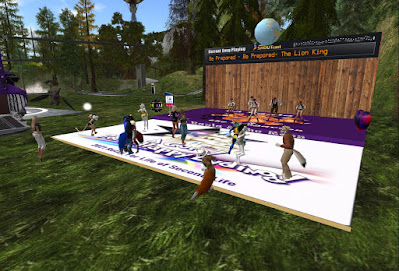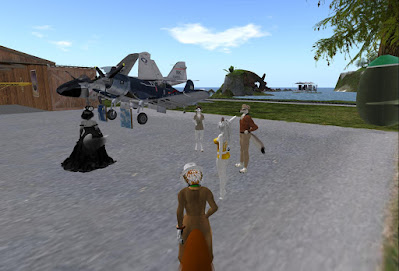By Bixyl Shuftan
Every year, the Relay's team Sunbeamers has an air show in it's Farshore Field in Sunlight Bay. For the team's history, an event of some kind has been held by the team at the airfield. And officially this is the eighth air show. From 8AM to 4PM SL time, there were a number of things taking place.
As always, there were a number of planes on display. But that wasn't all.
This season, the Sunbeamers were holding the event in cooperation with another team, "Roos With A Dream."
DJ Kayla performed on stage, dancing with other Roos.
The Roos had arrived in their own Chinook helicopter, painted Relay purple.
There was plenty of chatter during this performance. "Think of all the diseases have been wiped out or minimized in our lifetime," one of the Roos, Alison Flow, commented, "Cases due to wild poliovirus have decreased by over 99% since 1988, from an estimated 350,000 cases then, to 33 reported cases in 2018. In 1996, the total life expectancy for a 20-year-old person with HIV was 39 years. In 2011, the total life expectancy bumped up to about 70 years. And more currently, who would have thought that a brand new vaccine for COVID-19 would be going into people's arms as we speak. So, with your help, our dream isn't so far off! Cancer is next!!"
There was also some gaming chatter, notably "World of Warships." One commented, "I never got past teir four with WoWs, destroyers are glass cannons." And talk about Second Life, "Someone always sends me an IM asking me to come to his shows, and every time I respond with 'Sorry, at a RFL event.; Not sure he believes me, but true."
There were other aircraft around. Who knew the World Health Organization had black helicopters?
And from the US Coast Guard, a friendlier looking white helicopter.
Nearby was a B-17 Bomber
Introduced in 1938, this famous American heavy bomber would be the third most produced bomber of all time with over 12,700 made between then and 1945.
After the war, America retired the plane as a bomber, though it would be in other roles for a few years, including the CIA. Other countries continued to use it until Brazil retired it's last one in 1968.
As of now, 46 of the planes are still around, with nine airworthy for flight.
The plane had a normal crew of ten, the least popular position being the ball-turret belly gunner. It had a range of 2000 miles with a 6000 lb bomb load.
One fighter a B-17 crew didn't want to meet was the
Messerschmitt Me 262. The first operational jet fighter. Fortunately for the Allies, Hitler insisted many be used as fighter-bombers. After the war, some were still in service in Czechosolvokia for several years.
A
Curtis P-40 Warhawk, the plane used by the "Flying Tigers," American volunteers flying for China before Pearl Harbor. While Imperial Japanese fighters were more maneuverable, it was better armed, could absorb more damage, and was faster in a dive. The plane was produced until 1944 and after the war saw service in some countries as late as 1958.
An
A-6 Intruder and a
F4U Corsair. The Corsair would be continued to be produced after WW2 to 1953. They would continue to fly in other nations' air forces, and would be involved in the last dogfight involving propeller-driven fighters in the "
Football War" in 1969. The last one in service was retired in 1979.
A
P-51 Mustang, one of the most successful fighters of WW2. Introduced in January 1942, over 15,000 were made. America continued to use it until the Korean War. Other nations would continue to use them, The Dominican Republic retiring it's last one in 1984.
A
Supermarine Spitfire, introduced in 1938 and the chief Allied fighter in the Battle of Britain. It would be produced until 1948, and used by other countries until Ireland retired the last one in 1961.
A
Messerschmitt Bf 109, Germany's main fighter of WW2. The most produced fighter in history, almost 34,000 were built from Feb 1937 to the end of the war in May 1945. Updates allowed it to remained competitive with Allied fighters, though eventually were overpowered by sheer numbers. After the war, it continued to serve in the air forces of several other nations, including ironically enough Israel. Spain would retire the last one in active duty in 1965.

Among the more modern aircraft was this
A-10 Thunderbolt. It was build as a close air-support aircraft to destroy ground targets. With a rugged frame that takes a lot of punishment, huge bomb and missile loads and a devastating autocannon that fires armor-piercing ammo, it is a weapon to fear. Introduced in 1977, the "Warthog" was produced until 1984 and has served in several notable conflicts such as the Gulf War. While there is talk of replacing the A-10 and have more recent (and expensive) planes take up it's role, as of now there are no plans to retire the aircraft.
A talk between Air Show organizer Cynthia Farshore, Shockwave Yareach, Sunbeamer captain Rita Mariner, and Dusk Griswold.
Snowy (Skylark Lefavre) and Nikkita (Aubrytia Resident) were offering balloon rides.
Cynthia and Shockwave going up in a biplane.
I decided to join them with my own biplane, a
Nieuport 17.
Introduced in March 1916, the plane was superior to German fighters at the time, and established air superiority, for a time.
But by mid-1917, the planes began to be outclassed by newer German fighters. Eventually, the plane was less and less used on the Western Front and more limited to other theaters. It continued to be used in some air forces through the 1920s.
A Corsair would also see some air time.
There was also a cannon that would launch you up into the air. Grabbing a parachute first was highly recommended.
There was a free one provided at the show, near the cannon.
There were some other attractions, like this shooting gallery.
Violet Solano of Meli's Maniacs came by.
She was interested in learning to fly a plane she had.
Coming in for a landing.
Near the end of the event, Cynthia Farshore, announced the amount of Linden dollars raised. For Team Sunbeamers, the total was 32,143
Lindens. For Roos With a Dream, the amount was 20,100 Lindens. This made for a combined total of 52,243 Lindens.
For both teams, it was one more accomplishment, one that would be followed up by the Relaystock the following weekend. Then would come other events, such as a planed festival by the Sunbeamers. And of course there's the Relay Weekend in June.
Go Sunbeamers! Go Relay!
Bixyl Shuftan












































No comments:
Post a Comment